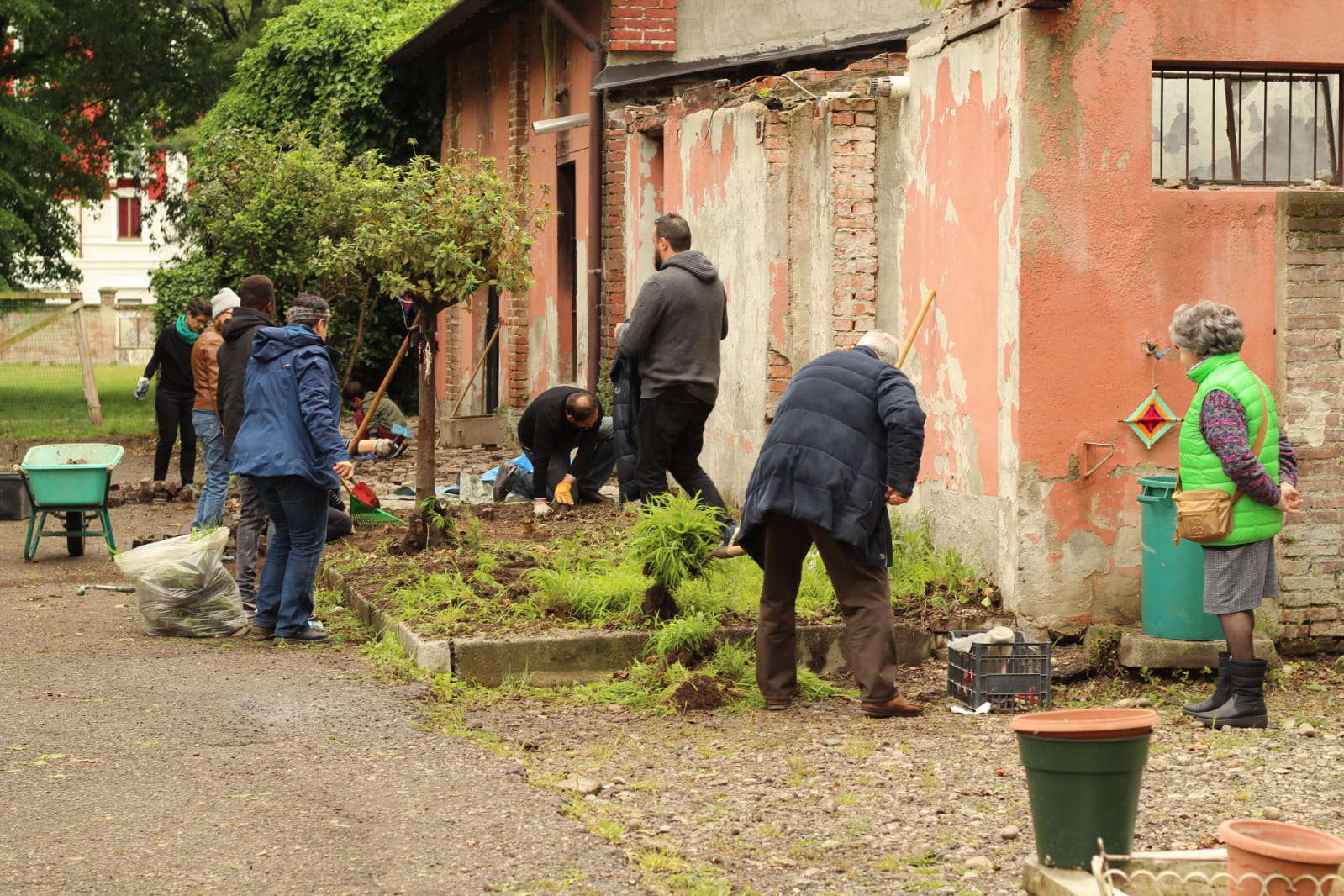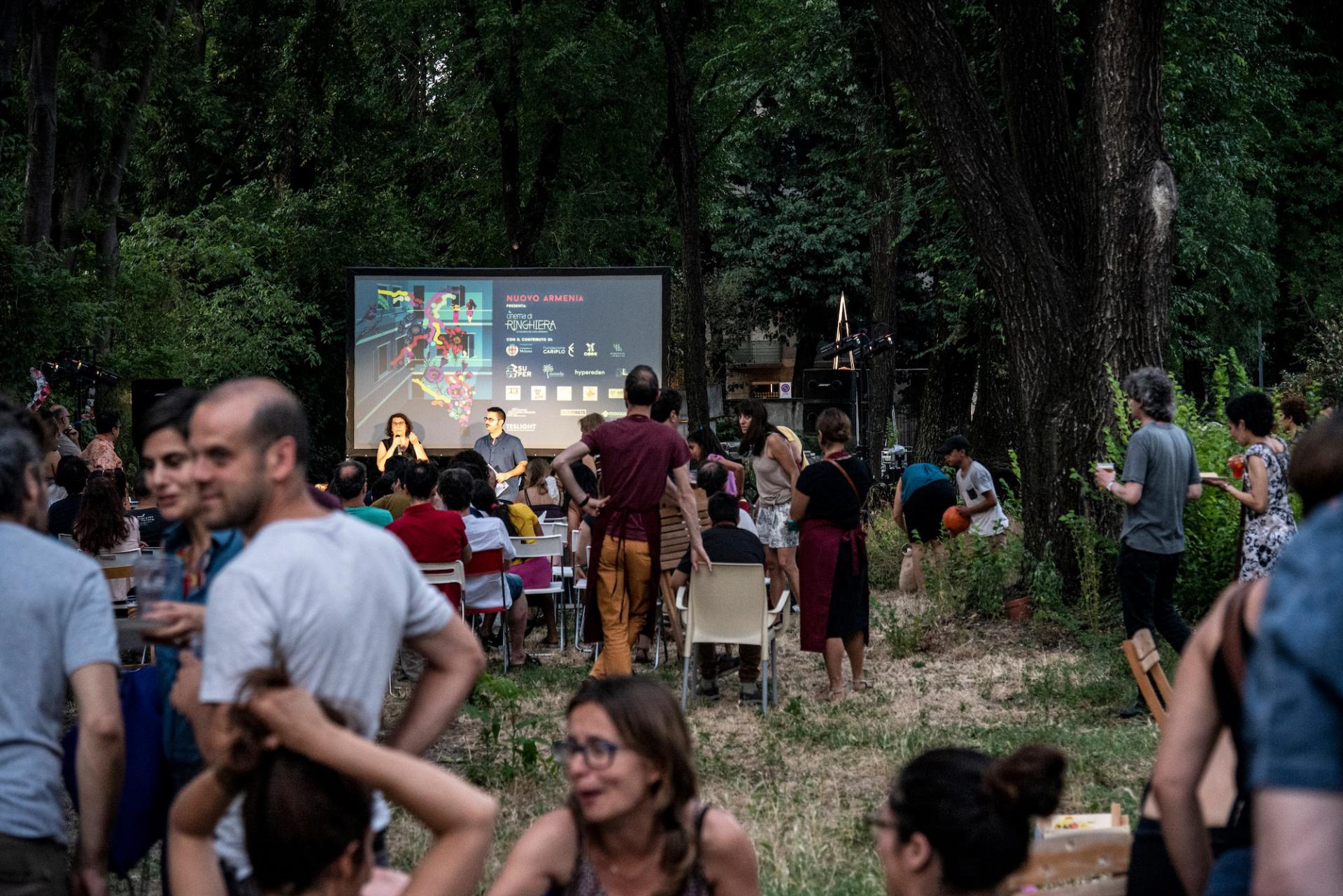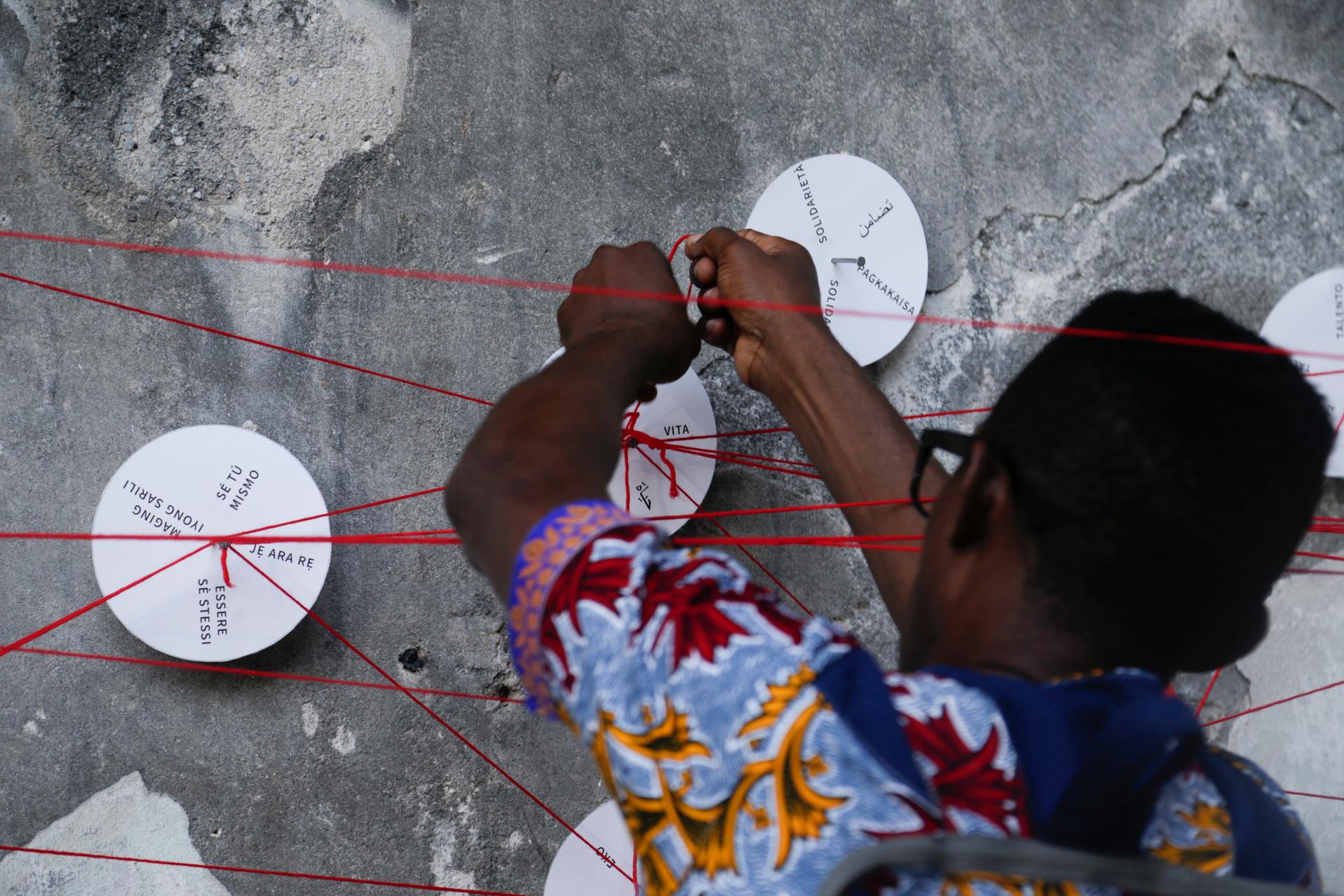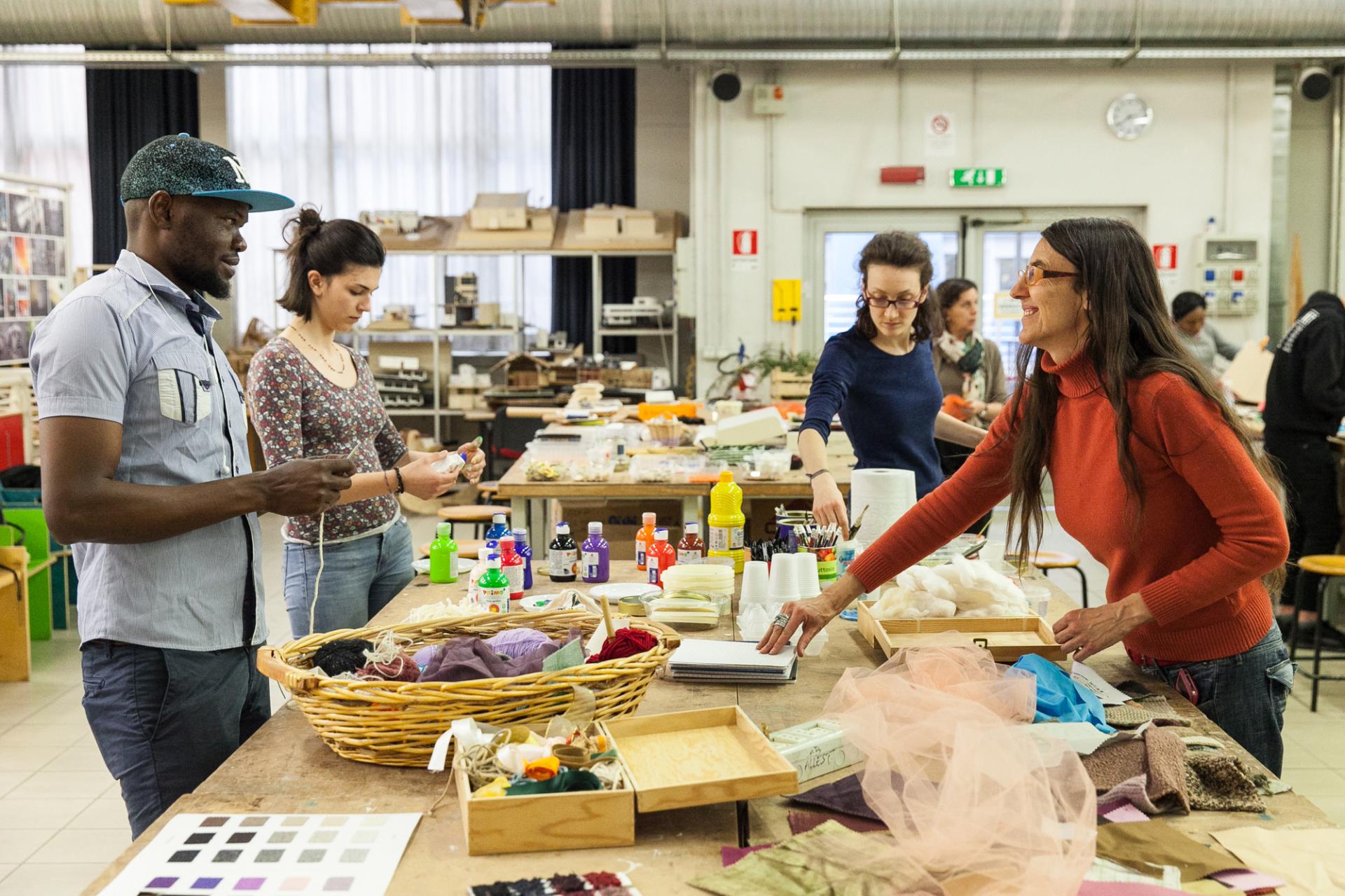Cascina 9
Basic information
Project Title
Full project title
Category
Project Description
Aesthetics is cultural activism! Cascina 9 piloted cultural experiences to develop a shared sense of ownership in a space inaccessible for decades in a suburban area of Milan. Politecnico di Milano Design Dep., Nuovo Armenia (producer of movies by second-generation directors), and Asnada (school of Italian) experimented scientific approach and competencies in art, design, digital media, storytelling, and education to bring the local community together fostering sustainable and cultural inclusion
Project Region
EU Programme or fund
Description of the project
Summary
Cascina 9 (Feb 2018-Oct 2019) prototyped events and cultural experiences to develop a shared sense of ownership in a space inaccessible for decades: the former stables of Villa Hanau -henceforth "farmhouse”- in Dergano, a suburban area of Milan. Three partners carried on the project: Politecnico di Milano, Design Department (leader); Nuovo Armenia association (producer and distributor of independent movies by second-generation emerging directors); and Asnada (school of Italian which offers intercultural workshops based on storytelling techniques). The project's mission was to combine art, design, and scientific approach for bringing the local community together in prototyping cultural performances and storytelling formats, fostering inclusive and sustainable cultural processes. The main goal was eliciting the synergy between the partners and the collaboration among them with other actors, including citizens. Throughout the project, the partners developed three main pillars: 1) the definition of a multichannel communication strategy, building the multicultural center's identity, promoting its activities, and involving the neighborhoods. The outputs were strategic guidelines adopted by the Nuovo Armenia association to continue even after the end of the project. 2) The involvement of the Italian and international students of the School of Design and the Asnada school, who met at the Bovisa Campus of Politecnico di Milano, exchanging personal stories and working on joint projects: the outputs were interactive storytelling projects ("Interactive Narratives" lab; "Scenarios and Propps" lab; "100 Places" lab) amplified through exhibitions and communicative actions in the territory (installation "Nodi di Parole"; exhibition "89 places: geographies of migration and rooting"; "The quest for the lost page," urban game on the Carnival 2019; final exhibition). 3) The architectural renovation project of the garden and the building in collaboration with the Hypereden association.
Key objectives for sustainability
The collaborative care of the farmhouse's space and the surrounding garden is one of the cornerstones of the architectural pillar of the project. Taking care of the location environment represented a powerful way for people to practice care of social relations and provided the opportunity to involve both audiences and citizens in social and environmental sustainable actions. The architectural project was characterized by a long-term strategy that operated strengthening the potential of the existing and practicing the continuous configuration of space in a different shapes. It considers the space open to new contributions by non-experts, continuous adaptations, and further extensions, according to the usage by the inhabitants and the citizens of the neighborhood. The idea was alternate moments of work with moments of conviviality and leisure, creating exchange opportunities among the participants to the activities: groups of volunteers set up spontaneously, following the call for participation on the social media profiles of Nuovo Armenia. Since the beginning, most of the efforts have aimed at cleaning up the garden from materials accumulated over the years of neglect and restoring the building damaged by a fire that broke out shortly before the delivery. The work started with volunteers' activities developed over a series of appointments called "It takes a flower and a nice help" (5 meetings in 2018, 5 in 2019). The intervention of a construction company and the collaboration of the Municipality of Milan and Amsa (Milanese Environmental Services Company), which removed the bulkiest waste and disposed of asbestos, supported the citizen's voluntary activities. As a result, the cleansing activity allows discovering the history of the space and the different uses across the years, up to a return to the original environment cleansed of toxic elements but renewed with a new and profound sense of care, rebirth, and ownership of the space.
Key objectives for aesthetics and quality
Cascina 9 is a situated project that prototyped aesthetics as a key to approaching sustainability and inclusion. The project supports social inclusion through collaborative processes of cultural activism based on storytelling, worldbuilding, and multichannel communication strategies. Words are enabling tools: speaking, telling stories and collaborative meaning-making implies taking a stand and acting. The project developed a new vocabulary of living together translated into different languages, applied to other cultural experiences.
The partners applied the concept of "care" to mutual relations, translating it to the collective activities of caring for the environment, listening, and engaging people in the collaborative process of designing a cultural center.
As an example, we briefly describe only one of the actions carried out focusing on its aesthetic qualities: the installation "Nodi di Parole" (Nodes of Words), created in June 2018 during the last evening of the "Cinema di Ringhiera" festival in a crumbling area of the farmhouse building, a room without a roof, still full of debris. The main goal was to bring new meanings into space: we collected 4 keywords (freedom, care, family, love) from the films screened during the festival, and we translated them into the original languages of the movies. The words were hung on the room walls, asking visitors to connect them to other keywords with a red thread, according to their experiences. As a result, the vision of a community emerged. The installation had the value of taking "care" of empty space, adding different meanings to the place: a negotiation process that left traces of ownership of a place that was previously not accessible. We can quote some of the feedback collected during the event from the participants: “Words made me remember, words made me travel without having to leave” (John); “It was nice to search for words and I liked the possibility of being able to insert new ones” (Federico).
Key objectives for inclusion
As an example, we describe the workshop "100 Places" and the exhibition "89 Places. Geographies of migration and rooting". Thirty-six students (refugees) of the Asnada school and students of the School of Design (Politecnico di Milano) met together for the workshop at the Bovisa campus. The students from Afghanistan, Albania, Costa Rica, Eritrea, Ethiopia, Gambia, Italy, Mali, Nigeria, Peru, Senegal, and Somalia explored the emotional bond of living in a group that supported mutual understanding. During the workshop, they replied to essential questions about living, migration, and rooting as needs of every human being. Moreover, they used only recycled materials. The reflection fostered and the reuse of waste has made it possible to explore further the concept of "care": giving new life to recovered objects and materials represented a layering of meanings. "Care" was also the meaning of an educational initiative that offered participants the opportunity to enhance their soft skills: students experienced an extraordinary atmosphere during the workshop, practicing the listening activity, sharing stories connected to the different artifacts, objects, and materials. The result was creating miniatures relating to essential places of one's past and present and a graphic elaboration (engraving on oil pastels) relating to an intermediate stage of their lives (the journey, a passage, a moment of transformation). The exhibition was hosted at the farmhouse and aimed at restoring the complexity of individual life paths. Curated by architect Giacomo Borella, it envisaged the construction of an affective geography. The intertwining of the threads that connected each stage of the personal journeys allowed visitors to follow individual paths without losing sight of the collective dimension of migration. While not everyone had a critical migration experience, the bond that every human being has with places emerged for everyone: rootedness is a fundamental need of the human being.
Results in relation to category
Cascina 9 represents the proof of concept of practicing an open and shared knowledge among cultural activists and researchers. The project developed cultural, human-centered, positive, and tangible experiences supporting social inclusion, such as events, art installations, urban games, co-design workshops dedicated to students, refugees, cultural activists, researchers, and citizens.
In terms of results and impacts, we focus specifically on the activities previously described. Inside the farmhouse area, the volunteer work for the garden produced surprising results, making tangible the change in terms of environmental landscape and accessibility of the space. It occurred thanks to the contribution of citizens who participated and acquired a shared sense of ownership of the area.
The collaborative process of identity building and the strategic guidelines provided by design researchers still represent the foundations of the vision and mission of Nuovo Armenia cultural center: nowadays all the communication channels and contents the partners lead are based on that output of the project.
In addition, cultural exchange has developed through hospitality and the permeability of spaces. During the “Interactive Narratives” Lab, the personal stories of refugee students became creative raw material for the students of the School of Design, who created interactive narratives for new media. These materials were first translated into narrative worlds and then became nine interactive narratives rooted in the territory, to be staged in New Armenia and in other places significant for local communities. The narratives were distributed both offline and online, in the form of Alternative Reality Games, Location-Based Mobile Games, immersive installations, visual novels, online series, adventures on Instagram and transmedia experiences. These outputs represent an example of how design and storytelling exploited digital technologies for the mobilization of culture, arts and communities.
How Citizens benefit
Cascina 9 developed a shared sense of ownership of a place that remained inaccessible for decades. Its requalification was intended for material matters - a transformation of spaces - and the immaterial dimension linked to social relations. The project experimented with collaborative in-field actions between a plurality of cultures and actors with complementary skills. The cultural contents resulting from the events, experiences, and co-design workshops confer to Nuovo Armenia and the partners' equity capable of getting growing audiences and participants' involvement generated by storytelling and meaning-making processes.
Further results are the formats for collaborative actions, such as the urban game “The quest for the lost page”. It was prototyped in March 2019 in the districts of Dergano and Bovisa. Children and families participated in a treasure hunt from the Bovisa campus of Politecnico di Milano to Nuovo Armenia. The realization involved traders and artisans of the neighborhood, who hosted some stages, providing clues and helping the players to find a precious lost page of Leonardo Da Vinci's Trivulziano Code. Some of them even provided discounts available at their stores activating a sustainable cycle for the local economy. Cascina 9 exploited digital technologies for the mobilization of culture, arts, and communities.
After the outbreak of the COVID-19 pandemic and the following restrictions no more activities were allowed. Even though Cascina 9 ended in October 2019, and later on Politecnico di Milano has no more officially involved, self-construction workshops will be soon activated by the partners and led by expert craftsmen for the realization of coverings, fabrics, and furnishing elements. It demonstrates how the approach of exchanging know-how and taking care of spaces and relationships still represents the core identity of Nuovo Armenia and how the aesthetic asset for sustainable community building keeps on germinating.
Innovative character
Cascina 9 practiced aesthetics as cultural activism. In methodological terms, the innovative character of the Cascina 9 project refers to the aesthetic and political approach to the use of storytelling and words as tools for informal education, and artistic and cultural productions: students, researchers, cultural activists, and citizens, being they foreign or Italian, spoke each other and participated directly to the construction of a new imaginary of migration and rooting, out of the typical school environment.
The partners place themselves within a process in which they often face the opportunity of exchanging roles: researchers and teachers learn from students, social workers, and cultural activists. Through in-field actions, the university is de-institutionalized (Illich 2010): on the one hand, by going out to have lectures and workshops in unconventional spaces (the urban outdoor, the school of Italian language, or the art center); on the other hand, bringing students and non-students together into the traditional classrooms and educational laboratories of the university campus. Therefore, knowledge production takes place thanks to a horizontal distribution of roles, which establishes from time to time "who imagines, translates, applies, invents innovative implementation procedures and tools" (Morelli and Sbordone, 2018).




